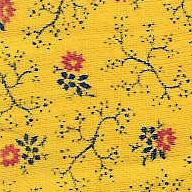|

Dear
Kimberly,
Several years ago I was able to purchase yardage of some antique
fabric.
I have begun cataloging the collection and would like to know more
about how to verify the age of these pieces.
I have used Barbara Brackman's
book
"Clues In The Calico" and Eileen Trestain's book "Dating
Fabrics," but
I am still unsure
about several of the pieces.
From my research thus far I
know that
the earliest pieces in my collection are the poison green, cheddar
orange, turkey red, and the bright yellows.
I also have several indigos,
double
pinks, maroon and mourning prints which came a little later. Where I was
able
to purchase yardage, there was a
label from American Prints Co. on it.
I would truly appreciate any information you could give me to steer me
in verifying the age and value of the
pieces. Thank you for any help you may be
able
to give me.
Sincerely,
Doris
Goins
Indiana
Hi Doris,
When
you have individual pieces of fabric, the Brackman and Trestain books
you mentioned are good for getting a date
range. In another book you might
find
the same piece of fabric that is in a dated quilt and that would
indicate
some sense of time too, but ladies had deep scrap bags back then.
Also, the fabrics you mention were made for
a long period of time, so it may
not
be possible to get exact. Salesman's sample cards would be another good
source and can be found as pictures in books
sometimes, check out Roderick
Kiracofe's
"The American Quilt".
In
general the acid greens, natural turkey red, chrome yellows and antimony orange
were around from about 1825 to 1890 in
America. Chrome or antimony orange solids continued on into the 20th
century. The same chrome yellow and red & black prints re-appeared
in the teens and again in the 1940s. The maroon, a synthetic dye
called
claret by Brackman was made between 1890-1910, as were Mourning prints
of grays and blacks. Indigo and double pinks were so popular they
span the century and continue into the next.
The print and method of
printing help
to date these a little more, but it is not always easy.
Value
with swatches and pieces of fabrics you describe are based on what the
buying public will bear. They are not rare,
nor were they expensive to make
at
the time they were made. But they are special and wonderful and
definitely
worth the care and
preservation you are giving them.
Thank
you for letting me use your question and prints on my Website, for other
readers to enjoy.
Kim
|